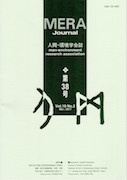Volume 7, Issue 2
Displaying 1-9 of 9 articles from this issue
- |<
- <
- 1
- >
- >|
-
Article type: Cover
2002 Volume 7 Issue 2 Pages Cover1-
Published: September 30, 2002
Released on J-STAGE: February 28, 2019
Download PDF (20K) -
Article type: Index
2002 Volume 7 Issue 2 Pages Toc1-
Published: September 30, 2002
Released on J-STAGE: February 28, 2019
Download PDF (24K) -
Article type: Article
2002 Volume 7 Issue 2 Pages 1-9
Published: September 30, 2002
Released on J-STAGE: February 28, 2019
Download PDF (1093K) -
Article type: Article
2002 Volume 7 Issue 2 Pages 11-20
Published: September 30, 2002
Released on J-STAGE: February 28, 2019
Download PDF (987K) -
Article type: Article
2002 Volume 7 Issue 2 Pages 21-30
Published: September 30, 2002
Released on J-STAGE: February 28, 2019
Download PDF (994K) -
Article type: Article
2002 Volume 7 Issue 2 Pages 31-40
Published: September 30, 2002
Released on J-STAGE: February 28, 2019
Download PDF (1466K) -
Article type: Appendix
2002 Volume 7 Issue 2 Pages App1-
Published: September 30, 2002
Released on J-STAGE: February 28, 2019
Download PDF (19K) -
Article type: Cover
2002 Volume 7 Issue 2 Pages Cover2-
Published: September 30, 2002
Released on J-STAGE: February 28, 2019
Download PDF (18K) -
Article type: Cover
2002 Volume 7 Issue 2 Pages Cover3-
Published: September 30, 2002
Released on J-STAGE: February 28, 2019
Download PDF (18K)
- |<
- <
- 1
- >
- >|
